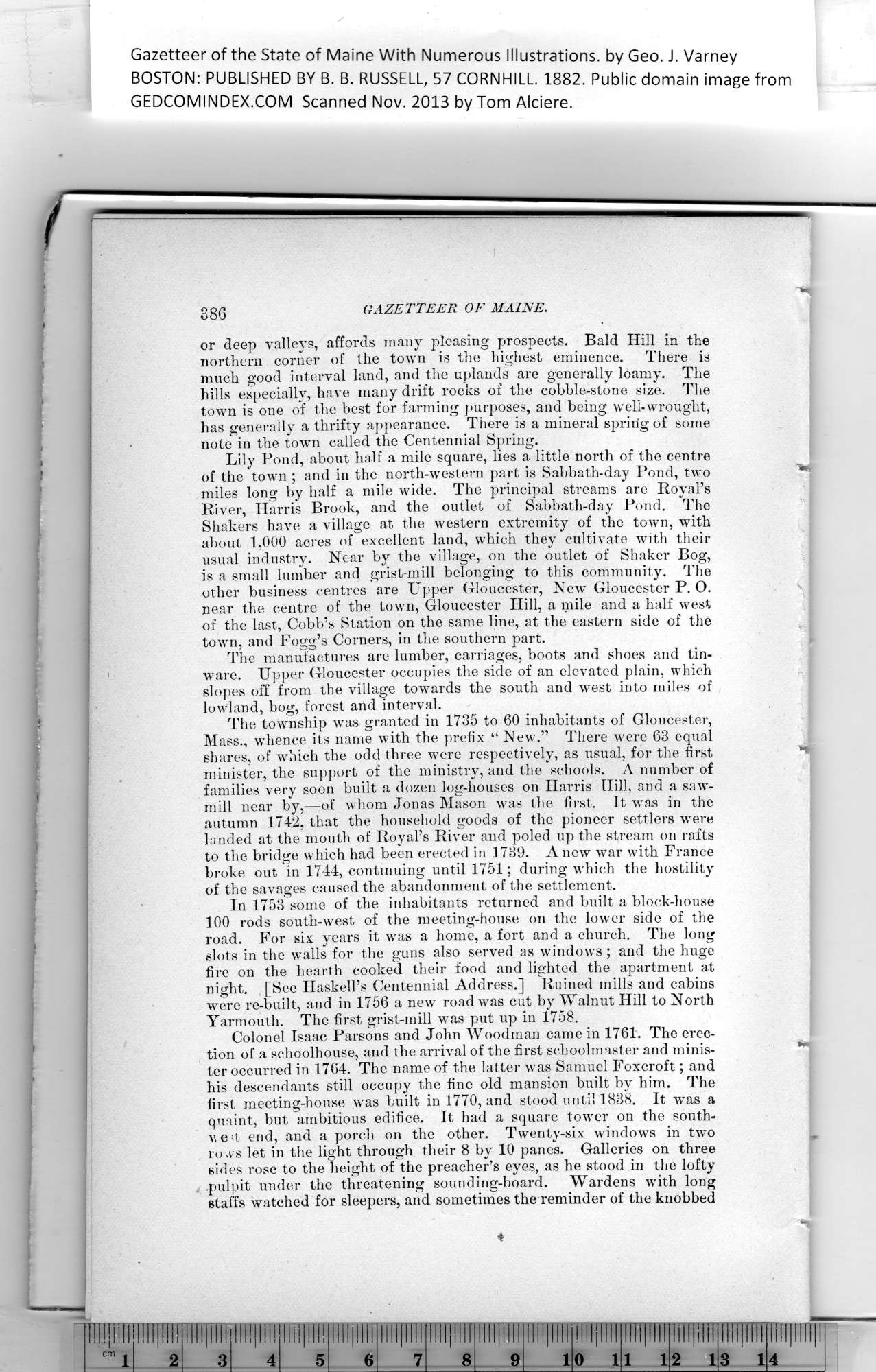|
Gazetteer of the State of Maine With Numerous Illustrations, by Geo. J. Varney
BOSTON: PUBLISHED BY B. B. RUSSELL, 57 CORNHILL. 1882. Public domain image from
GAZETTEER OF MAINE.
or deep valleys, affords many pleasing prospects. Bald Hill in the
northern corner of the town is the highest eminence. There is
much good interval land, and the uplands are generally loamy. The
hills especially, have many drift rocks of the cobble-stone size. The
town is one of the best for farming purposes, and being well-wrought,
has generally a thrifty appearance. There is a mineral spring of some
note in the town called the Centennial Spring.
Lily Pond, about half a mile square, lies a little north of the centre
of the town ; and in the north-western part is Sabbath-day Pond, two
miles long hy half a mile wide. The principal streams are Royal’s
River, Harris Brook, and the outlet of Sabbath-day Pond. The
Shakers have a village at the western extremity of the town, with
about 1,000 acres of excellent land, which they cultivate with their
usual industry. Near by the village, on the outlet of Shaker Bog,
is a small lumber and grist-mill belonging to this community. The
other business centres are Upper Gloucester, New Gloucester P. O.
near the centre of the town, Gloucester Hill, a mile and a half west
of the last, Cobb’s Station on the same line, at the eastern side of the
town, and Fogg’s Corners, in the southern part.
The manufactures are lumber, carriages, boots and shoes and tin-
> ware. Upper Gloucester occupies the side of an elevated plain, which
slopes off from the village towards the south and west into miles of
lowland, hog, forest and interval.
The township was granted in 1735 to 60 inhabitants of Gloucester,
Mass., whence its name with the prefix “ New.” There were 63 equal
shares, of which the odd three were respectively, as usual, for the first ^
minister, the support of the ministry, and the schools. A number of
families very soon built a dozen log-houses on Harris Hill, and a saw-
mill near by,—of whom Jonas Mason was the first. It was in the
autumn 1742, that the household goods of the pioneer settlers were
landed at the mouth of Royal’s River and poled up the stream on rafts
to the bridge which had been erected in 1739. Anew war with France
broke out in 1744, continuing until 1751; during which the hostility
of the savages caused the abandonment of the settlement.
In 1753 some of the inhabitants returned and built a block-house
100 rods south-west of the meeting-house on the lower side of the
road. For six years it was a home, a fort and a church. The long
slots in the walls for the guns also served as windows ; and the huge
fire on the hearth cooked their food and lighted the apartment at
night. [See Haskell’s Centennial Address.] Ruined mills and cabins
wrere re-built, and in 1756 a new road was cut by Walnut Hill to North
Yarmouth. The first grist-mill was put up in 1758.
Colonel Isaac Parsons and John Woodman came in 1761. The erec-
tion of a schoolhouse, and the arrival of the first schoolmaster and minis- **!
ter occurred in 1764. The name of the latter was Samuel Foxcroft; and
his descendants still occupy the fine old mansion built by him. The
first meeting-house was built in 1770, and stood until 1838. It was a
quaint, but ambitious edifice. It had a square tower on the south-
veit end, and a porch on the other. Twenty-six windows in two
rows let in the light through their 8 by 10 panes. Galleries on three
sides rose to the height of the preacher’s eyes, as he stood in the lofty
pulpit under the threatening sounding-board. Wardens with long
staffs watched for sleepers, and sometimes the reminder of the knobbed
386
PREVIOUS PAGE ... NEXT PAGE
This page was written in HTML using a program written in Python 3.2
|
